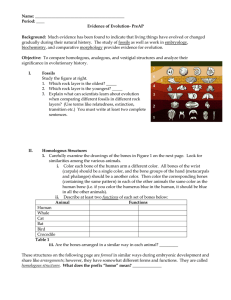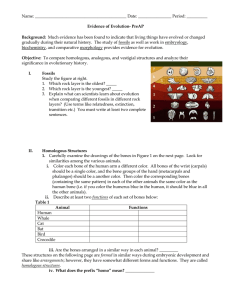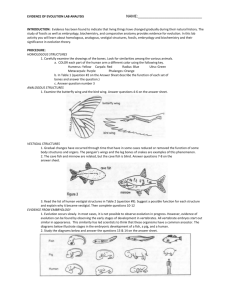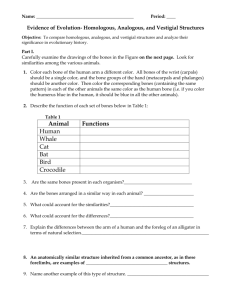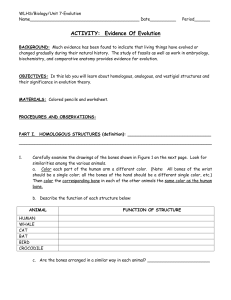Evolution Lab Analysis: Homologous, Analogous, Vestigial Structures
advertisement
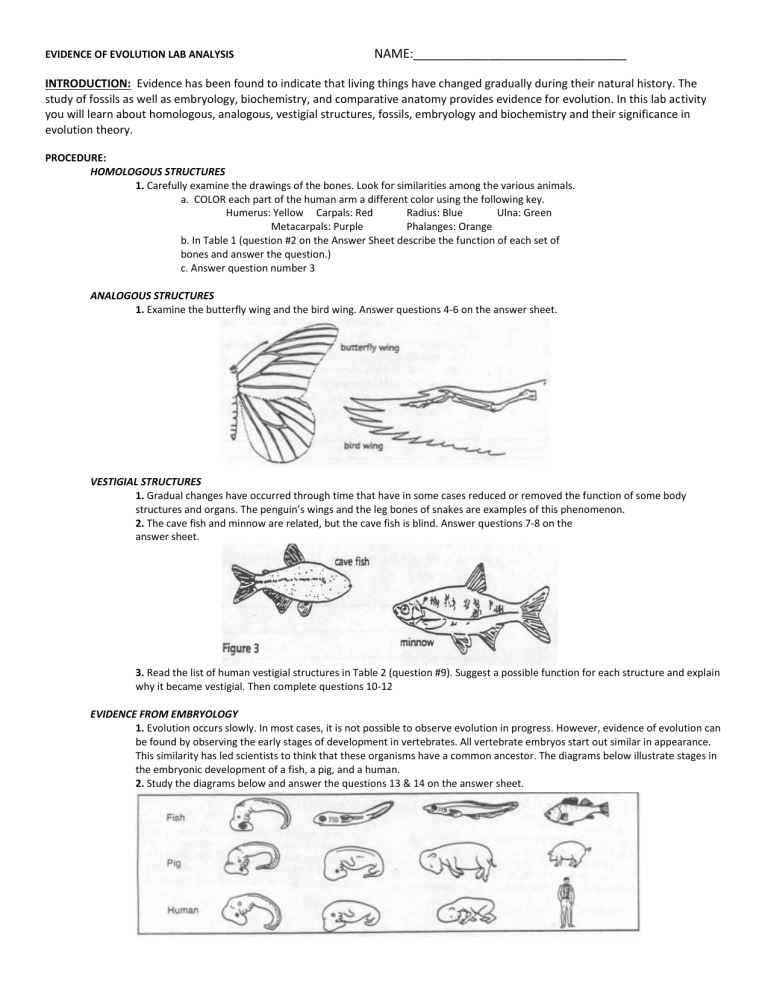
EVIDENCE OF EVOLUTION LAB ANALYSIS NAME:_______________________________ INTRODUCTION: Evidence has been found to indicate that living things have changed gradually during their natural history. The study of fossils as well as embryology, biochemistry, and comparative anatomy provides evidence for evolution. In this lab activity you will learn about homologous, analogous, vestigial structures, fossils, embryology and biochemistry and their significance in evolution theory. PROCEDURE: HOMOLOGOUS STRUCTURES 1. Carefully examine the drawings of the bones. Look for similarities among the various animals. a. COLOR each part of the human arm a different color using the following key. Humerus: Yellow Carpals: Red Radius: Blue Ulna: Green Metacarpals: Purple Phalanges: Orange b. In Table 1 (question #2 on the Answer Sheet describe the function of each set of bones and answer the question.) c. Answer question number 3 ANALOGOUS STRUCTURES 1. Examine the butterfly wing and the bird wing. Answer questions 4-6 on the answer sheet. VESTIGIAL STRUCTURES 1. Gradual changes have occurred through time that have in some cases reduced or removed the function of some body structures and organs. The penguin’s wings and the leg bones of snakes are examples of this phenomenon. 2. The cave fish and minnow are related, but the cave fish is blind. Answer questions 7-8 on the answer sheet. 3. Read the list of human vestigial structures in Table 2 (question #9). Suggest a possible function for each structure and explain why it became vestigial. Then complete questions 10-12 EVIDENCE FROM EMBRYOLOGY 1. Evolution occurs slowly. In most cases, it is not possible to observe evolution in progress. However, evidence of evolution can be found by observing the early stages of development in vertebrates. All vertebrate embryos start out similar in appearance. This similarity has led scientists to think that these organisms have a common ancestor. The diagrams below illustrate stages in the embryonic development of a fish, a pig, and a human. 2. Study the diagrams below and answer the questions 13 & 14 on the answer sheet. EVIDENCE OF EVOLUTION LAB ANALYSIS NAME:_______________________________ Data: Homologous Structures: 1. COLOR the bones according to instructions. 2. Use the following “word bank” to match each animal’s bones above with their function. Flying Flying Walking, Running, and Standing Swimming Swimming, Walking, Running, and Standing Grasping and Balance 3. Are the bones arranged in a similar way in each animal? _______________________________ These structures are formed in similar ways during embryonic development and share like arrangements. However, they have somewhat different forms and functions. They’re called HOMOLOGOUS STRUCTURES. EVIDENCE OF EVOLUTION LAB ANALYSIS NAME:_______________________________ Analogous Structures: 4. What function do the butterfly and bird wing structures share? ____________________________________________________________________________________ 5. How do the structures of the butterfly and bird wings differ? ____________________________________________________________________________________ 6. Do birds and insects share any structural similarities that would suggest they are closely related? ____________________________________________________________________________________ Some apparently unrelated animals have organs with similar function, yet are very different in structure and form. These structures are called ANALOGOUS STRUCTURES. VESTIGIAL STRUCTURES: 7. Explain why eyesight is not an important adaptation to life in a cave. _____________________________________________________________________________________ 8. Does the appearance of the cave fish and minnow suggest common ancestry?_____________Why? __________________________________________________________________________________ Organs or structures that lost their function in the organism and become reduced in size (because of efficiency) are called VESTIGIAL STRUCTURES. Human vestigial organs are well documented. 9. Read the list of human vestigial structures shown below. Suggest a possible function for each structure and explain why it became vestigial. Analysis and Interpretations of Homologous, Analogous and Vestigial Structures: 10. Explain why the homologous structures of bones are evidence evolutionary relationships. 11. Explain the evolutionary relationship between the fin of a fish and flipper of a whale. 12. How do you think vestigial structures came about? EVIDENCE OF EVOLUTION LAB ANALYSIS NAME:_______________________________ EMBRYOLOGY: 13. How does a comparison of the embryos provide evidence of evolution? 14. Which of the organisms would be most biochemically similar to humans: fish or pig? _________ Conclusions: 15. COMPLETE THE CHART by checking the kind of evidence described. In many organisms we observe similarities in development
